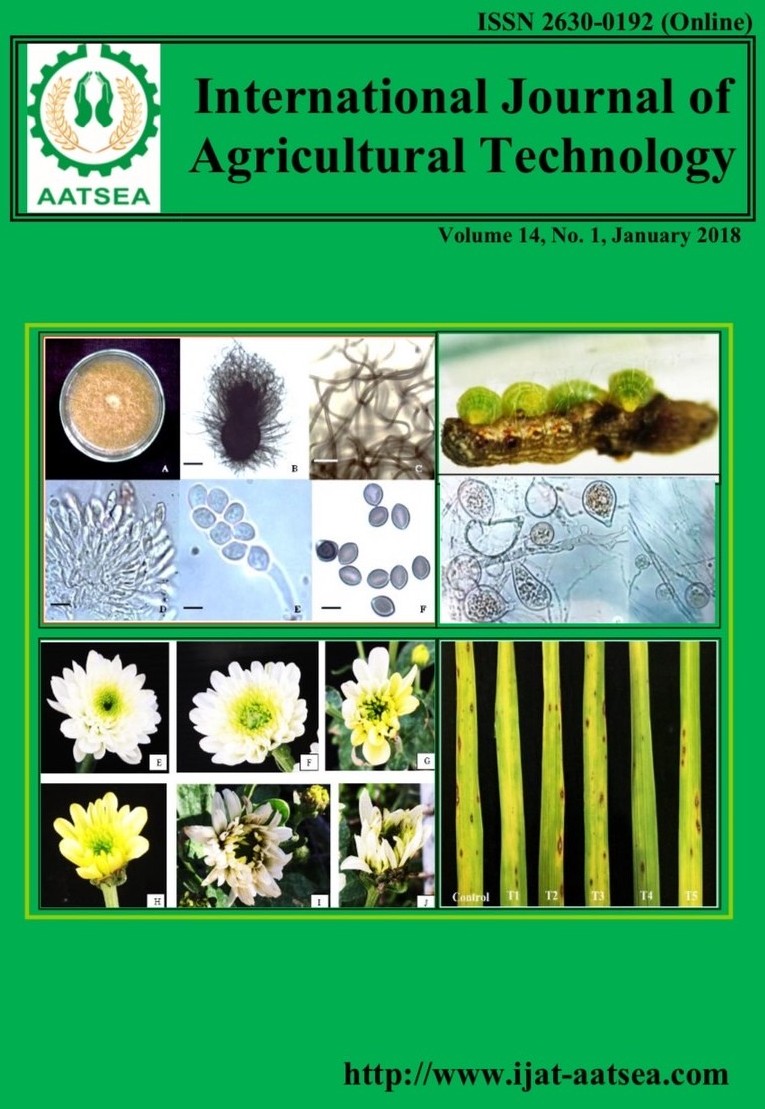Methanol Extract and Nanocomposite of Trichoderma sp as a Potential Bio-Control against Fusarium moniliforme in Tomato (Lycopersicon esculentum)
Main Article Content
Abstract
Nanotechnology has been cited as the foundation of a new advanced agriculture. It is a rapidly developing domain of research and practice. The potential uses and benefits of nanotechnology are enormous. These include plant disease management through the formulation of nanomaterials-based products. Use of pesticides and fungicides has been found to be effective against different plant pathogens but the large use of these chemicals can lead to serious problems, including environmental pollution and human health hazards. Therefore, alternative strategies are being widely employed. One potential strategy to counter attack pathogen is the use of bio-control agents. Trichoderma sp. is widely studied bio-control agent against plant pathogens because of their ability to reduce the population of soil borne plant pathogens including Fusarium sp. that causes wilt in tomato. The study determined the effectiveness of methanol extract and nanocomposite of Trichoderma sp. as a potential bio-control against Fusarium moniliforme in tomato through in- vitro and in- vivo conditions. In-vitro assays conducted were bi-culture and slide bi-culture while in-vivo assay was done using modified leaf assay. In-vitro results revealed that Trichoderma sp. colonized F. moniliforme and suppressed the growth by an average of 2.84 cm which resulted to damaged and deformed hyphae. In-vivo results showed that the methanol extract of Trichoderma sp. reduced the disease incidence and severity, while the nanoTrichoderma extract did not. Given the results, it can be concluded that Trichoderma sp. had antagonistic property in controlling growth of Fusarium moniliforme.
Article Details

This work is licensed under a Creative Commons Attribution-NonCommercial-NoDerivatives 4.0 International License.
References
Chet, I., Inbar, J. and Hadar, I. (1997). Fungal antagonists and mycoparasites. In: The Mycota IV: Environmental and microbial relationships. Springer-Verlag, Berlin, pp. 165-184.
Dana, M. M., Limón, M. C., Mejías, R., Mach, R. L., Benítez, T., Pintor-Toro, J. A. and Kubicek, C. P. (2001). Regulation of chitinase 33 (chit33) gene expression in Trichoderma harzianum. Current Genet 38:335-342.
Elad, Y., Freeman, S. and Monte, E. (2000). Biocontrol agents: Mode of action and interaction with other means of control. IOBC wprs Bulletin, Sevilla, España.
Harman, G. E., Howell, C. R., Viterbo, A., Chet, I. and Lorito, M. (2004). Trichoderma species-opportunistic, avirulent plant symbionts. Nature Reviews 2:43-56.
Hung, P. M., Pongnak, W. and Soytong, K. (2013). Isolation plant pathogens from pomelo and their pathogenicity test. Faculty of Agricultural Technology, King Mongkut’s Institute of Technology Ladkrabang (KMITL), Bangkok, Thailand.
Papavizas, G. C. (1985). Trichoderma and Gliocladium: Biology, ecology, and potential for biocontrol. Annual Review of Phytopathology 23:23-54.
Sharma, P. (2011). Complexity of Trichoderma-Fusarium interaction and manifestation of biological control. Department of Microbiology, Mata Gujri.
Sibounnavong, P., Chaoenporn, C., Kanokmedhakul, S. and Soytong, K. (2012). Antifungal metabolites from antagonistic fungi used to control tomato wilt fungus, Fusarium oxysporum f sp lycopersici. African Journal of Biotechnology 10:19714-19722.
Vey, A., Hoagland, R. E. and Butt, T. M. (2001). Toxic metabolites of fungal biocontrol agents. In: Fungi as biocontrol agents: Progress, problems and potential. CAB International, Bristology, pp. 311-346.


